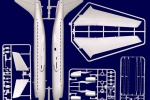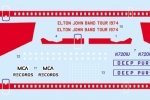1⁄144
Tuesday, June 10, 2014 - 12:48 PM UTC
Roden has announced a new version of their Boeing 720.
From Roden's Website.
At the beginning of the 1950's the Boeing company created one of the greatest planes of the Twentieth Century - the Boeing 707, which undoubtedly initiated the era of passenger jet travel for the masses. In 1957, the company's management decided to modify the aircraft for possible use on medium-range routes and on runways of shorter length.
Thus the Boeing 720 was developed, which in comparison with its predecessor was slightly shorter (the fuselage was reduced by 2.45m) and had a redesigned wing and in general was more straightforward to operate than the Boeing 707. Pratt & Whitney JT3C-7 engines were installed in the airplane. On November 23, 1959 its first flight took place, and 65 were constructed. A year later a more advanced modification was developed, the Boeing 720B, with JT3D engines. The principal operators of the Boeing 720 were US airlines, although a small number was sold to Germany, Israel, Pakistan, Ireland and some other countries.
The history of the operation of the Boeing 720 as a passenger plane was mostly unexceptional, as most other airliners, but at least one machine out of the relatively small number built, left behind some special memories - not just in aviation history but in the history of the rock music of the Twentieth Century. This machine with the serial number N7201U was delivered to United Airlines and was used by it on internal routes from 1960 to 1973.
In 1973 famous former American actor and singer Bobby Sherman together with his manager Ward Sylvester, co-owners of artists agency Contemporary Entertainment, purchased the plane from United Airlines with the intent of converting it into a convenient and comfortable 'flying hotel' for effecting flights between cities and out of the country by various artists. The music industry during this period was at its peak - a considerable number of performers of all styles of music plied their trade on numerous tours of the territory of the USA, and without any particular financial drawbacks the considerable fees received by them for concerts at that time allowed them to rent the plane for fast and comfortable travel from city to city.
The well-known band Led Zeppelin was the first of many acts who fully appreciated the advantages of such VIP accommodation. Their manager Peter Grant never held back over issues connected with comfort for the members of the group, and so for Zeppelin's tours, which often covered some tens of cities of the USA during the season, Starship One was a real find.
In 1973 Reginald Kenneth Dwight, better known in the world of music as British pop idol Elton John, released his latest album 'Goodbye Yellow Brick Road'. In its support a huge world tour was planned, and for the American part of the tour the singer's manager immediately turned to Bobby Sherman to ask him about renting a plane. Led Zeppelin's tour had just finished, and Starship One was available for some time. The ship was immediately stencilled with the inscription of its 'new owner' and Elton John flew in it from city to city, one performance to another. He was delighted with the comfort of the 'hotel in the sky' and the next year, when his follow-up album 'Caribou' appeared and the question of a new tour arose, the pop idol's managers agreed with Bobby Sherman on another lease of Starship One. This time the aircraft was painted in a new scheme, a blue fuselage bottom with numerous stars and a red vertical tail. In this form, and labelled as the Elton John band tour 1974, in the fall of the same year the singer made a highly successful tour across the United States.
At the beginning of the 1950's the Boeing company created one of the greatest planes of the Twentieth Century - the Boeing 707, which undoubtedly initiated the era of passenger jet travel for the masses. In 1957, the company's management decided to modify the aircraft for possible use on medium-range routes and on runways of shorter length.
Thus the Boeing 720 was developed, which in comparison with its predecessor was slightly shorter (the fuselage was reduced by 2.45m) and had a redesigned wing and in general was more straightforward to operate than the Boeing 707. Pratt & Whitney JT3C-7 engines were installed in the airplane. On November 23, 1959 its first flight took place, and 65 were constructed. A year later a more advanced modification was developed, the Boeing 720B, with JT3D engines. The principal operators of the Boeing 720 were US airlines, although a small number was sold to Germany, Israel, Pakistan, Ireland and some other countries.
The history of the operation of the Boeing 720 as a passenger plane was mostly unexceptional, as most other airliners, but at least one machine out of the relatively small number built, left behind some special memories - not just in aviation history but in the history of the rock music of the Twentieth Century. This machine with the serial number N7201U was delivered to United Airlines and was used by it on internal routes from 1960 to 1973.
In 1973 famous former American actor and singer Bobby Sherman together with his manager Ward Sylvester, co-owners of artists agency Contemporary Entertainment, purchased the plane from United Airlines with the intent of converting it into a convenient and comfortable 'flying hotel' for effecting flights between cities and out of the country by various artists. The music industry during this period was at its peak - a considerable number of performers of all styles of music plied their trade on numerous tours of the territory of the USA, and without any particular financial drawbacks the considerable fees received by them for concerts at that time allowed them to rent the plane for fast and comfortable travel from city to city.
The well-known band Led Zeppelin was the first of many acts who fully appreciated the advantages of such VIP accommodation. Their manager Peter Grant never held back over issues connected with comfort for the members of the group, and so for Zeppelin's tours, which often covered some tens of cities of the USA during the season, Starship One was a real find.
In 1973 Reginald Kenneth Dwight, better known in the world of music as British pop idol Elton John, released his latest album 'Goodbye Yellow Brick Road'. In its support a huge world tour was planned, and for the American part of the tour the singer's manager immediately turned to Bobby Sherman to ask him about renting a plane. Led Zeppelin's tour had just finished, and Starship One was available for some time. The ship was immediately stencilled with the inscription of its 'new owner' and Elton John flew in it from city to city, one performance to another. He was delighted with the comfort of the 'hotel in the sky' and the next year, when his follow-up album 'Caribou' appeared and the question of a new tour arose, the pop idol's managers agreed with Bobby Sherman on another lease of Starship One. This time the aircraft was painted in a new scheme, a blue fuselage bottom with numerous stars and a red vertical tail. In this form, and labelled as the Elton John band tour 1974, in the fall of the same year the singer made a highly successful tour across the United States.
Click Star to Rate
3 readers have rated this story.
THIS STORY HAS BEEN READ 6,041 TIMES.
| Roden Reviews | MORE |
| Pt-17 Kaydet by Kevin Brant | of 1 ratings, 100% found this helpful | |
| Focke-Wulf FW200C-6 Condor by Kevin Brant | |
| Boeing 307 by Is a secret | |
| Britannia 312 by Is a secret | of 2 ratings, 100% found this helpful | |
| Heinkel He 51B-1 by Rowan Baylis | of 2 ratings, 100% found this helpful | |
| C-123B Provider by Is a secret | of 1 ratings, 100% found this helpful | |
| PC-6 B2/H4 by Richard Tonge | |
| Boeing 720 by Is a secret | of 2 ratings, 100% found this helpful | |
| Douglas DC-3 by Is a secret | |
| Douglas C-47 build by Richard Tonge | of 1 ratings, 100% found this helpful | |
| Trojan C by Richard West | |
| Douglas C-47 by Richard Tonge | of 1 ratings, 100% found this helpful | |
| Globemaster II by Tim Hatton | of 1 ratings, 100% found this helpful | |
| ATL.98 Carvair by Tim Hatton | of 3 ratings, 100% found this helpful | |
| Turbo Porter float plane by Richard Tonge | of 2 ratings, 100% found this helpful | |










